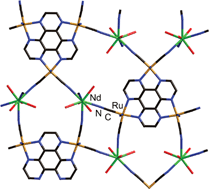Polynuclear cyanoruthenate chromophores based on hexaaza-triphenylene containing up to twelve cyanides: photophysical and structural properties†
Abstract
The complexes [Ru(CN)4(HAT)]2−, [{Ru(CN)4}2(μ2-HAT)]4− and [{Ru(CN)4}3(μ3-HAT)]6− (HAT = hexaaza-


 Please wait while we load your content...
Please wait while we load your content...